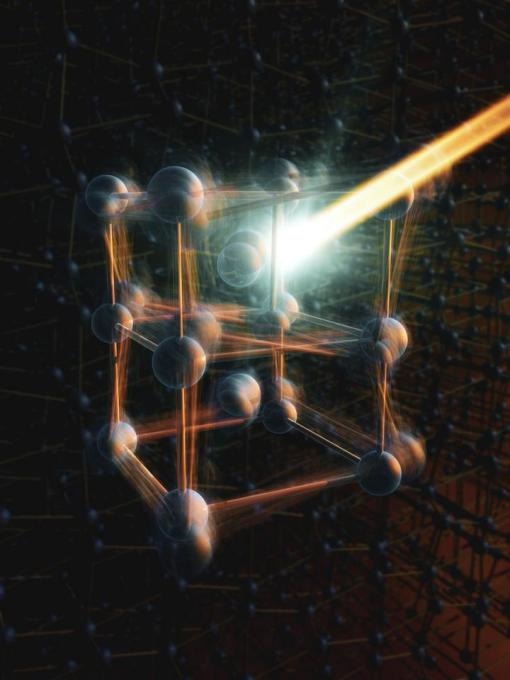Nov 5 2018
Phase transitions often occur that considerably change a material’s properties—the most familiar one being the solid-liquid-gas transition in water. Every phase relates to a new arrangement of the atoms inside the material, which governs the substance’s properties.
 This is a schematic illustration of the vanadium dioxide atomic structure. (Image credit: Greg Stewart/SLAC National Accelerator Laboratory)
This is a schematic illustration of the vanadium dioxide atomic structure. (Image credit: Greg Stewart/SLAC National Accelerator Laboratory)
Although such arrangements can be effortlessly analyzed in each phase separately, it is much more difficult to analyze how they are able to alter their arrangements from one state to the other at the time of a phase transition. The reason for this is that atoms are remarkably small, and the distances by which they travel are also equally small, and hence they can occur quite rapidly. Materials also contain more than 1023 atoms, making it highly difficult to monitor their individual motions.
The insulator-metal transition that occurs in the material vanadium dioxide (VO2) is one specifically intriguing phase change. VO2 is an insulator at room temperature, and the vanadium ions within the crystal form periodic chains of vanadium pairs called dimers. Upon heating this compound to just above room temperature, there is a change in the atomic structure and the periodic chains of vanadium pairs break down; however, the material continues to be a solid. Simultaneously, the material’s conductivity increases by more than five orders of magnitude and has a wide range of applications, spanning from infrared sensing to energy-free climate control.
One interesting property of VO2 is that the phase transition can take place very quickly with the only limitation appearing to be how rapidly the system can be heated. To explain this remarkable speed, researchers proposed that there should be a cooperative motion between the vanadium ions—that is, each vanadium pair breaks in the same manner simultaneously.
In order to infer the materials’ atomic structure, the researchers applied a method called diffraction. Over the past three decades, this technique has been expanded to include time resolution so as to achieve the “molecular movie,” that is, to directly film the atoms’ movement at the time of transition. In 2007, this technique was initially applied to VO2, where it appeared to validate the picture of coordinated motion.
Conversely, diffraction is only capable of measuring the average atomic position and does not reveal much information regarding the exact path adopted by the individual atoms involved. For instance, protesters parading down the avenue Passeig de Gràcia in Barcelona will move in a regular, uniform, coordinated manner, while a group of tourists might cover the same distance, on average, yet in an entirely uncoordinated manner, randomly halting and wandering around to gaze at the city’s architecture. In the case of diffraction, both these processes would appear the same.
Now, in a new study, reported in Science, a team of researchers has applied a novel method that has the potential to overcome the atomic pathways. The study involved ICFO researchers Professor Simon Wall, PhD student Luciana Vidas, and former post doc Timothy miller, in association with researchers from SLAC National Accelerator Laboratory, Japan Synchrotron Radiation Research Institute, Duke University, Oak Ridge National Laboratory, and Stanford University.
To accomplish this, the team leveraged the world’s first X-ray laser located in the SLAC National Accelerator Laboratory. This innovative light source allowed the investigators to study the structure of the crystal with unparalleled details with the help of a method called total X-ray scattering. Contrary to the existing view, the authors discovered that the vanadium pairs broke down in a highly disorderly way and appeared more like the tourists rather than the marchers.
This is the first time we have really been able to observe how atoms re-arrange in a phase transition without assuming the motion is uniform and suggests that the text book understanding of these transitions needs to be re-written. We now plan to use this technique to explore more materials to understand how wide-spread the role of disorder is.
Simon Wall, Professor, ICFO.
So far, VO2 has often been applied as a guide for interpreting the phases in more intricate materials, for example, high-temperature superconductors. Therefore, the lessons learnt here indicate that such materials will also have to be examined again. In addition, comprehending the role of disorder in vibrational materials could point to a new perspective on how to regulate matter, particularly in the superconductivity field, which could have important implications for optoelectronics and nanotechnology.